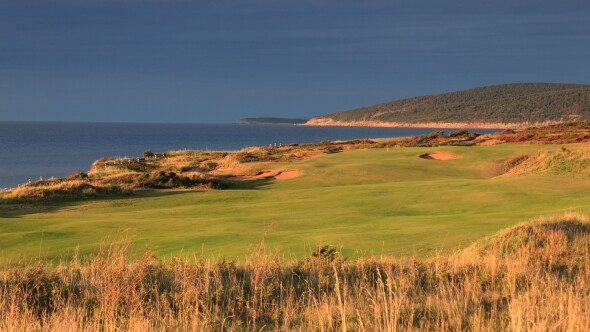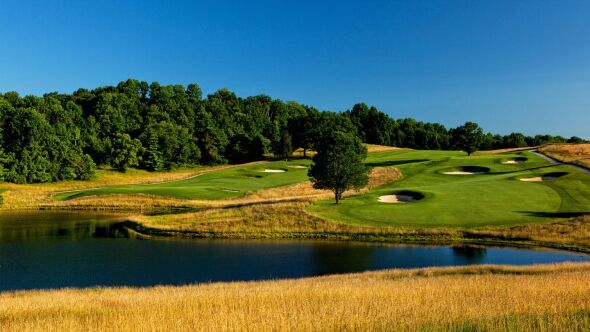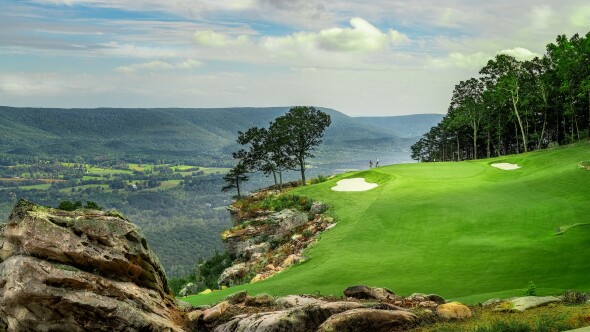Two years ago, golf course architect Dan Fry walked out onto a vast expanse of pine-tree laden land south of Arcadia, Michigan and had one of those moments of inspiration.
“There wasn’t much to look at other than some very gentle slope across the site,” says Fry. He was with owner Rich Postma, who had built the first course at Arcadia Bluffs on a rollicking, dramatic ground overlooking Lake Michigan. But now, two miles south of that land and landlocked on a parcel nowhere near water, the elements of an interesting course would all have to be created. The land included former apple and peach orchards, a barley field, grassy meadows, hardwood stands and spruce trees.
“I turned to Postma,” recalls Fry, “and told him that if he cleared the land he could build a really cool version of a Chicago Golf Club.”
Fry didn’t know it at the time, but Chicago Golf Club was Postma’s favorite course. Its original 1893 design by Charles Blair Macdonald in Wheaton, Illinois, as revised into its contemporary form by Seth Raynor in 1922, was legendary for the way its angular, linear bunkering and platform greens popped out of the flat land. Months later Fry found out that Postma chose the site for its suitability for an "old school" layout.
Fry’s idea wasn’t to build a collection of famous template Macdonald-Raynor holes like those that formed Old Macdonald at Bandon Dunes in Oregon. "I just thought it would be really interesting to create something inspired by Chicago Golf that would contrast with the original course at Arcadia Bluffs."
The South Course at Arcadia Bluffs does just that. It’s broad, inviting and deceptively simply design hides a tract that offers multiple pathways across and over steep-walled, flat-floor bunkers that protrude partly across the line of play without creating a forced carry. The choice of whether to challenge a bunker or play for open space is up to each golfer. And they are readily accommodated on this par-72 layout with five tees set out at yardages of 5,281-5,814-6,380-6,932-7,412.
The fairways are massive - 50-70 yards wide - with the main challenge evident in greens that average 9,400 square feet. For all their expanse these finely grown-in bentgrass surfaces are linear, at times box-like in shape, with pronounced interior divides that section off the greens and allow them to play totally differently from one day to the next. And just so we are sure where we are, Fry has even created squared off rear corners where no sane greenkeeper would ever locate a hole location. They aren’t just there for show, however. They’re also there to forge an edginess to the design that makes the features stand out on an otherwise undistinguished platform embracing 311 acres.
For all that space, there’s a comfortable connectivity of green-to-next-tee that makes the South readily walkable – something that is facilitated by pull carts. It all presents a sharp contrast with the original course up the road. The Bluffs, a highly rated layout designed by Warren Henderson and Rick Smith opened in 2000 that rocks and rolls over faux Irish dunes that include a handful of emotionally overwhelming holes atop cliffs that plummet into Lake Michigan.
Fry, 56, is a veteran designer and member of the American Society of Golf Course Architects. He’s a former varsity golfer with the University of Arizona who learned how to shape while working for the Tom Fazio team during its heyday in the late 1980s and early 1990s. After learning the trade on the likes of Wade Hampton, Black Diamond Ranch, Lake Nona he teamed up with architect Michael Hurdzan, whom he helped make the leap from functional, low-key golf to new-found drama. Fry’s repertoire with Hurdzan included such eye-openers as Erin Hills in Wisconsin, Devil’s Pulpit and Devil’s Paintbrush outside Toronto, Naples National and Calusa Pines in Naples, Florida, and Desert Willow Resort in Palm Desert, California.
A decade ago, Fry formed a partnership with Jason Straka, with whom he collaborated on Arcadia Bluffs-South as their latest co-produced product, though it was Fry who spent the bulk of the time on site. The result is a powerful contrast and not a second course but a co-equal alternative to the first course. Now, with a much-expanded resort and overnight accommodations and amenities a successful resort in the northwest of mainland Michigan has even more appeal to visitors from near and far.
The South Course does not reveal its charms all at once. Given the variety of hole locations and the openness to variable winds it will take repeat play to learn the lay of the land. Among the many alluring holes to be found there, the humpback green on the mid-length par-3 fifth hole stands out. The putting surface on the par-5 sixth deserves special mention for the wildness of the surface. And at the long par-3 16th hole, golfers have to deal with a deep grassy-hollow version of the famed Redan.
It’s a course whose firmness and speed invite creative putting from well outside the green fillpad – sometimes from 50-60 yards.
Still in its early days, the course has a look of stunning horizontal scale that will benefit from completion of a clubhouse and turn-stand. But there are no plans to add interior trees to the site. The look of inviting ground will remain.
Green fee: $75-$125
optional cart included
walking always encouraged
caddies and forecaddies available






























Played here in 40-50 mph winds. The exposed nature of the course made for a test of survival. I am looking forward to the next trip to N. Michigan to play these two gems.